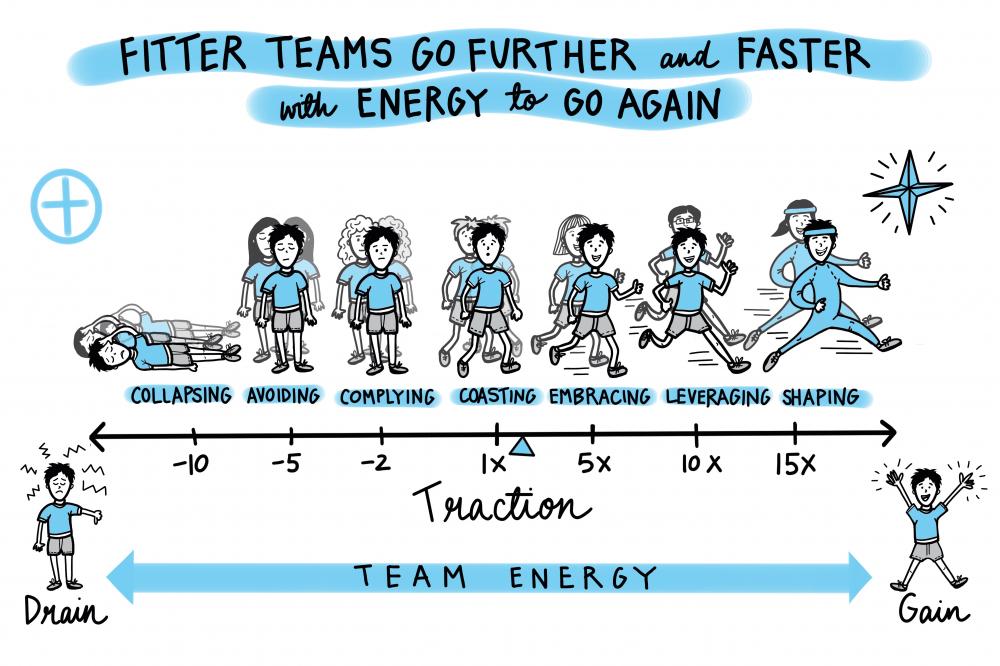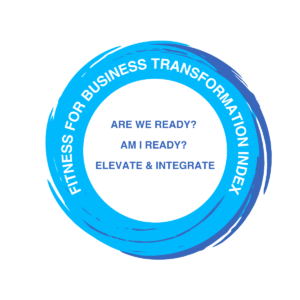Fitter teams go further, faster, and have the energy to go again.
Our ‘change-fitness’ as a leadership team is very much like our physical fitness as there is a tipping
point where doing more we gain energy.
On the other side of the tipping point, the cumulative initiatives and change efforts drain energy,
which may result in disengagement, burn-out, leadership churn, or what is commonly referred to as
change-fatigue.
Unfortunately for many leadership teams in these turbulent times pushing on through change-
fatigue is seen as ‘part of it’. Just how it is in demanding senior management roles.
With all the focus on the latest initiative, tactic, crisis, or change program the underlying change-
fitness is often not as regularly discussed, and in many leadership teams not effectively worked on at
all.
There are a lot of people to worry about in these turbulent times. I find my focus with you, the
leaders that others depend on. Only so much progress can be made on adrenaline and crisis
response. The underlying change-fitness becomes the greatest enabler, or constraint, for ongoing
adaption and intentional progress.
Reflecting on my experience across many organisations on the pre-conditions for effective strategy
execution, what those I have worked with know we called the ‘setting up for success’ phase of
developing and implementing new strategic phases, I could see there were factors that were not
well explained, particularly for an environment where it is clear transformation is required over and
over, and over again. I have then been researching extensively at the intersections of strategy/
futurist research/ leadership/ management/ execution/ and transformation.
In gathering and refining the thinking around this topic I have found utilising the fitness metaphor
for leadership teams enables us to readily relate and make accessible the attributes of the levels of
leadership team ‘change-fitness’, the ‘vital signs’ to be able to assess your leadership team, the
practices to improve team fitness, and examples of ‘exercises’ that can be incorporated into
leadership teams working to improve traction towards your goals and simultaneously improve
capabilities and energy for the inevitable next wave of change.
We all have a general understanding of what it means to be fit and that it is not a one dimensional
attribute. Fitness includes strength, endurance, cardiovascular capacity, and flexibility. Change-
fitness includes culture, strategic resilience, inner leadership development, and team dynamics.
We understand fitness from life rather than theory and that improving or maintaining fitness
requires activity. It is not a spectator game, or the intellectual pursuit of critics.
Fitness is not an end in itself, it is a means to an end, a targeted event or a quality of life and
longevity enabler. It relates to the finite mindset of setting a base to win a specific event or season
and to the infinite mindset of maximising engagement and contribution of a fulfilled life.
Fitness is something we can improve. We can all relate to phases of life where fitness may not have
been front of mind. Change-fitness is similar. It is not a priority until it is. We understand there is a
link between fitness and our personal resilience. Managing your energy and expectation is key when
facing a physical or mental set back. Many people rebuild physical fitness in times of adversity
because physical fitness can help us better address our current situation. Those with higher fitness
can take on things that appear impossible to those lower on the fitness ladder. With coaching and a
plan, we are able to move to a targeted level. What we thought was impossible can become within
reach our capabilities.
When people realise they have become unfit and commit to activity, they find it becomes a positive
lifestyle change. Such people take on challenges perceived to be beyond their limits such as running
a marathon, and elite athletes break world records and achieve feats previously deemed humanly
impossible. It’s about increasing your threshold, not wishing life was without challenges.
It has been my experience that keeping fit and building fitness can be a lot of fun. Shared
experiences can be a wonderful social connection. Many people form deep friendships through
sport, their local gym or walking group. I find the same happens in an environment of building
change-fitness. I treasure the relationships built in exposing gaps, exploring reality, expanding
options and pathways, and creating and exerting energy to follow through.
What are your experiences and insights?
Bernie
